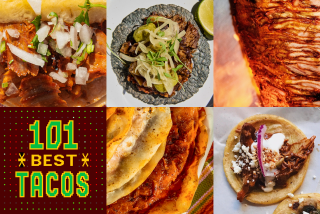The USDA 88-2 (Super Nova) may be your favorite new fruit. It’s a mandarin orange, not a ‘Star Wars’ thing
There’s a new mandarin orange in town: the Super Nova. For almost 50 years, the fruit has tantalized visitors to university citrus variety collections with its gorgeous dark orange color, its convenient seedlessness, its rich balance of sweetness and acidity — and its superb aromatics. Now, this mandarin is finally available commercially. And although the citrus won’t chase Cuties and Halos from markets any time soon, its excellence is outmatched only by the curious convolutions of its history and nomenclature.
It was in 1966 that Jack Hearn, an Orlando-based citrus breeder for the U.S. Department of Agriculture, crossed two sibling mandarin varieties, Lee and Nova, seeking to understand their pollination requirements. By chance, one such hybrid, then called 6-13-44, had extraordinarily fine flavor and was seedless, a rare trait among mandarins at the time. It had only one problem: The trees bore no fruit.
“In 34 years, I’ve seen it yield a good crop exactly once,” said Randall Driggers, a USDA researcher based in Fort Pierce, Fla.
Hoping the variety might produce better in California, Hearn in 1988 sent budwood for propagating to UC Riverside, where it became known as USDA 88-2, Lee × Nova (thanks to its parentage) and Novalee. There, indeed, the trees did bear moderately successful crops, though not exactly gangbusters.
As California mandarin production boomed in the 2000s, two large companies — which now sell the Halos and Cuties brands — dominated the market.
LoBue Citrus, growers based in Lindsay, southeast of Fresno, tasted USDA 88-2 at a university field station in Exeter and in 2010 started planting 70 acres, hoping to establish a premium niche. A few other growers put in smaller groves, which are mostly bearing their first substantial crop this month.
But what to call this fruit of many awkward names? USDA 88-2 doesn’t exactly trip off the tongue.
Robert LoBue, general manager of LoBue Citrus, first considered naming the mandarins “Novaleena,” a lovely name, although one that might sound a bit too much like a Longfellow poem. Then he decided that Super Nova was a better moniker, a name that is inspired by the fruit’s bright orange color and blazing flavor. And yes, the brand will be trademarked, so other growers have to come up with their own names. Will they be as much fun as a mandarin named for an exploding star?
Where to find super-premium mandarins:
Super Novas will be available starting this weekend at Super King, Vintage Grocers and Vicente Foods. Grow markets sell organic Novalees (which are unwaxed) from Deer Creek Heights Ranch. Friend’s Ranches of Ojai offers unwaxed Lee × Novas at the Santa Monica Wednesday and Hollywood farmers markets.
Two other super-premium varieties are coming into season. Large, easy to peel, seedless and richly flavored, Sumo has ruled the specialty mandarin world since its domestic introduction in 2011. This season’s huge crop just hit the shelves at Whole Foods, Bristol Farms and Gelson’s. And starting Jan. 18, after an absence of two years, Jonelle George of Lindsay, Calif., will return to the Santa Monica Wednesday market with unwaxed Sumos.
Next week, Friend’s Ranches will offer the ultimate connoisseur’s mandarin, DaisySL, with smooth, dark orange skin, firm flesh that melts in the mouth, and a fantastically intense, complex flavor — like tangerine candy. Polito Farms also will have them, at the Santa Monica, La Cienega and Venice farmers markets.
More to Read
Eat your way across L.A.
Get our weekly Tasting Notes newsletter for reviews, news and more.
You may occasionally receive promotional content from the Los Angeles Times.








